Starting the dishwasher for the first time: how to properly turn on the equipment for the first time
Buying and using a dishwasher for the first time is an exciting experience. Great expectations are placed on household appliances.It is she who should save the housewife from unpleasant everyday work. However, before starting active operation, it is necessary to test the unit. Don't know how to do this?
We will help you prepare your dishwasher for use. The article describes in detail the process of idle start-up, outlines the rules for putting the unit into operation, and also provides tips on choosing the appropriate washing program and servicing the equipment.
The content of the article:
Dishwasher testing
When a long-awaited device appears in the house, the owner wants to immediately turn it on and check its functionality.
There's no need to rush. First, you should carefully read the instructions so that standard operation of the equipment does not appear to be signs of breakdown.

The operation of dishwashers from different manufacturers can vary significantly, so appliance manufacturers provide detailed instructions for the first start-up. Do not ignore their recommendations, otherwise you may encounter unexpected problems during operation of the device.
Purpose of checking the dishwasher
Before turning it on for the first time, it is mandatory to test the dishwasher - run one cycle without loading dishes.
This check has several purposes:
- Cleaning. After manufacturing at the factory, traces of lubricants and small particles of debris remain inside the parts of new equipment. While the car is in the store, it is inspected and touched with hands, which leads to the appearance of stains. A test run removes dirt and prepares the equipment for use.
- Functionality check. During the first switching on, defects in the manufacturing of the equipment appear. If it was damaged during transportation, this will also become obvious.
- Monitoring correct installation and connection. There is always a place for unfortunate accidents in life. The installers could have made a mistake during installation, connection to the water supply or sewerage system. Sometimes they simply forget to remove the shipping elements. The test will reveal any shortcomings.
- User training. Even if this is not your first dishwasher, you still have to get used to the new equipment. Machines from different manufacturers have their own characteristics, and you need to deal with them before the device is put into operation.
For a test run, you will need a starter kit - detergent, salt and rinse aid. It is either purchased separately specifically for testing the machine, or the one that is planned to be used for washing dishes in the future is used. This will help you decide on the amount of salt and type of detergent.

Sometimes users make the mistake of running the first cycle without detergent, loading only salt. In this way they are trying to save an extra tablet or dose of gel. Do not do this. Hot water will wash away the technical lubricant, but traces of the greasy composition may remain under the rubber bands.
Procedure for idle start
First of all, the dishwasher is carefully inspected. You need to make sure that it is not damaged and that there are no foreign objects in the camera. Sometimes foam sealing inserts, stickers, etc. are forgotten inside the device. If everything is in order, you can turn on the machine and unscrew the valve that shuts off the water.
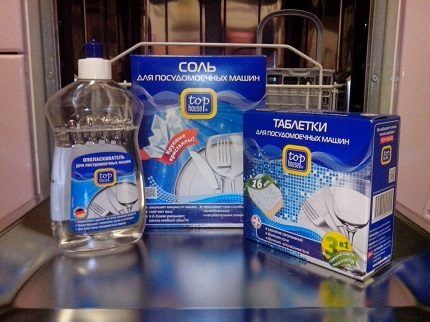
Then they proceed according to the following scheme:
- Check whether the machine is level.
- All supply and outlet hoses must be securely connected and joints sealed. Make sure of this.
- Open the camera door. You need to check whether the sprayer rotates freely. To do this you need to turn it several times.
- The drain filter is unscrewed, thoroughly washed with running water and household chemicals, and then replaced.
- When selecting detergents, you need to find ones that will not damage machine parts. The required amount of salt and rinse aid is calculated immediately in order to set a program for the future.
- When all the preparatory work is completed, the machine is set to the longest dishwashing mode without loading the basket. It is important that the temperature is as high as possible.
- All that remains is to close the door tightly, start the dishwasher and monitor its operation. If everything is going well, there is no need to interfere and try to improve something.
To regenerating salt does not stick together while the machine is running, pour about a liter of clean water into the empty compartment.
Only after this procedure can it be filled out. The recommended amount of liquid is 300-500 g.

If the dishwasher itself does not detect the chemicals, you need to manually enter the type of detergents and salt supply mode into the settings. Modern machines remember the entered parameters.
Aspects requiring attention
While the dishwasher operates in test mode, you need to check the following functions:
- water supply — normally it operates uninterruptedly, the machine does not stop;
- heat — you should make sure that the heating element is in order; it cannot be checked in a store, so only a test run can reveal problems;
- drain - water must flow out completely and without delay;
- drying — you need to check whether moisture remains in the chamber after the end of the cycle.
If there are no complaints about the functionality of the dishwasher, it can be put into full operation. Do not load dishes once the machine has completed the test cycle. It needs to cool down, so it's best to wait a couple of hours.
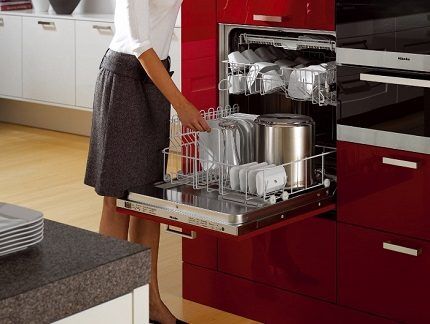
Sometimes a test run is entrusted to a master who installed and connected the dishwasher. This makes sense if such equipment has never been in the house or there is cause for concern regarding a specific model. Most often, the concern is unfounded.
Getting started - first operational start
This stage is started only after a test run of the PMM in idle mode. Otherwise, even if everything is in order with the equipment, traces of industrial grease may remain on clean dishes. These substances are potentially dangerous. It’s better not to save money and risk your health.
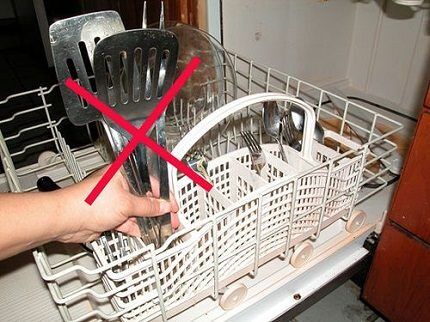
Before starting operation, you will have to spend a little time and deal with pressing issues. You need to take care of selecting detergents, preparations for preventive maintenance, learn how to load the basket correctly, and find the optimal program for your existing cutlery.
We offer step-by-step instructions for preparing to turn on the dishwasher for the first time in operating mode.
Step 1: selection of household chemicals
To keep your dishes consistently clean, you need to decide on the best products for your particular machine model.
You should focus on the following criteria:
- Release form. There are powder, tablet, and gel formulations. The quality of dishwashing and the cost-effectiveness of product consumption depend on the choice.
- Compound. Complex chemical preparations may contain several active ingredients. Each performs its own function and copes best with a certain type of task. You should choose depending on the type of cookware.
- Safety. Harsh chemicals can be harmful to health. It is better not to use certain brands of products if there are children, old people, pregnant women, allergy sufferers, and asthmatics in the house.
- Price. A dishwasher saves the housewife time and effort, but this does not mean that you should go broke. You need to decide on the budget that will be allocated monthly for household chemicals and select formulations that are suitable for the price.
Besides detergents, you will also need compounds for water softening, manual and automatic cleaning of the dishwasher, removing scale from the walls of the chamber, heating element and other parts of the machine.
Before purchasing detergents, you should carefully read the ingredients on the packaging. The active ingredients are selected depending on the type of dishes available and the usual degree of contamination.
Aggressive products contain chlorine. They perfectly wash away stubborn stains and remove stains from coffee, tea, and herbal infusions. Another advantage is a pronounced whitening effect.
Chlorine compounds are a good choice for cookware with durable coatings, but they are not suitable for delicate cutlery. They cannot be used for washing silver, cupronickel, thin and fragile porcelain and crystal items. If the dishes have hand-paintings on them, they may be seriously damaged in the machine.
An alternative to chlorine is enzymes. These are slightly alkaline substances that carefully wash away all types of contaminants. They do not damage delicate surfaces and work even in cold water. The downside is the lack of whitening effect.
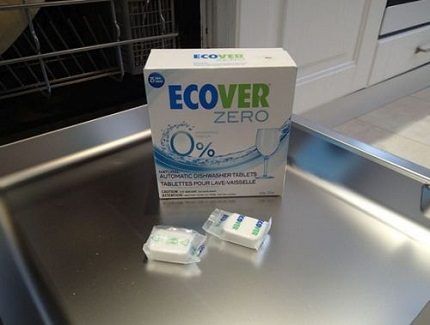
Families with small children, allergy sufferers and asthmatics are better off buying detergents labeled “eco”. They do not contain aggressive chemicals, dyes or other hazardous substances.
Thanks to their natural composition, eco-products do not cause allergic reactions or asthmatic attacks. The disadvantages include the questionable quality of dishwashing and traces of grease on the internal parts of the dishwasher. It will have to be cleaned of plaque more often.
Step 2: Loading the cart correctly
The dishes are placed in the machine so that they do not interfere with the rotation of the sprinklers. Plates and pots should be completely washed with water. It is necessary that the liquid flows freely, otherwise subsequent drying will be difficult, and drops or stains will remain on the surfaces.
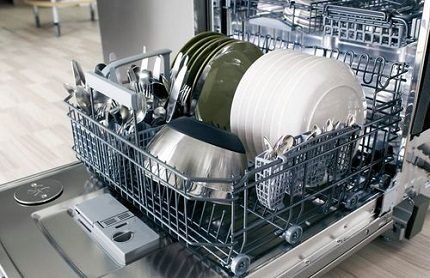
You should follow a few simple rules dishwasher loading:
- The basket is loaded from the lower compartment. The largest and heaviest objects are placed here.
- The top tray is designed for light dishes. Along with spoons, forks and knives, you can put lids from cans and bottles.
- If you need to wash a large pot for which there is not enough space, you can remove the top tray.
- There should be space between plates, bowls, and pans so that water can flow freely into each recess. To improve the cleaning quality, you can tilt the dishes a little forward.
- If you need to wash a plastic salad bowl or container, place it in the top tray. There is a heating element at the bottom of the machine that can partially melt the material.
Before loading dishes, you need to remove any remaining food from them. In some cases, it makes sense to manually rinse heavily soiled items under running water. This is necessary to prevent premature clogging of the filters.
We invite you to familiarize yourself with the list of what is allowed to be washed in the dishwasher and what is prohibited. A complete list of such items is presented in this article.
A visual aid to loading the dishwasher will help you carry out this part of the work correctly:
Step 3: Finding a suitable program
In order for the dishes to be completely cleaned, you need to correctly set the program that determines the parameters wash cycle. All models provide approximately the same options, but they are called differently. This can make it difficult to find a suitable regime.

It is worth understanding the standard functions:
- Soak. The program is designed for two types of dishwashing - preliminary and main. It is worth choosing if food remains have dried or burnt on your plates and pots. This mode is also suitable for washing large amounts of fat and dough.
- High intensity washing. Heavily soiled dishes without burnt or dried-on food can be washed without soaking. In this case, the quality of cleaning is ensured due to the high temperature of the water. The program is not suitable for delicate dishes with delicate coatings or plastic items.
- Standard mode. Allows you to get good results with optimal energy consumption. The program is intended for dishes that are normally soiled.
- Economy mode. If your cutlery is free of grease or dried-on food, it can be cleaned with minimal consumption of electricity and water.
- Delicate wash. Thin and delicate dishes require gentle care. The delicate mode is set for fragile sets, porcelain, and crystal.
- Quick wash. This is simply rinsing the dishes with household chemicals and then with clean water. The program does not provide for thorough cleaning of surfaces or drying.
For an idle test run, it is better to select a high-intensity mode, and for subsequent switching on, find the optimal program.
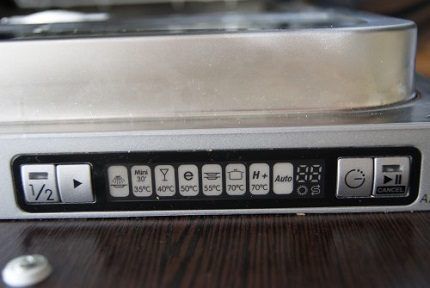
You should check how the machine washed the first batch of dishes. If traces of dirt remain, you will have to adjust the regime or add detergent.
If there are stains on the plates, increase the amount of rinse aid.
Conclusions and useful video on the topic
New household appliances seem difficult to use, but this is only at first. Once you understand how it works, there will be no problems. To make your first steps in using a dishwasher easier, we suggest you watch several thematic videos.
Testing and first launch of PMM:
A dishwasher will save the housewife from the need to soak, boil dishes, and scrape off burnt-on food debris. You just need to make sure that the equipment is working, decide on the necessary functions and buy the right household chemicals.
Test the new appliance, adjust the settings and enjoy your vacation, and leave the unpleasant kitchen chores to the dishwasher.
Do you have experience connecting and starting a dishwasher yourself? Or want to ask questions on the topic? Please comment on the post and participate in discussions. The feedback block is located below.




When we bought our dishwasher, the store didn’t say anything about turning it on for the first time, and I didn’t even ask. Then I went online for useful information. It turned out that it needs to be run idle like a washing machine. Of course, at first my dishes were not washed very well, I thought that they had hired a bad dishwasher. But it turns out I just placed everything in the basket incorrectly, now this is no longer the case. Now I’m wondering how I ever lived without her.
All this information - both about the first start and about how to properly place the dishes in the machine - is most likely in the instructions for the dishwasher. Get used to reading it and following the recommendations, then all devices will work longer and cause you fewer problems.
Nothing like this, Evgenia, for the very expensive dishwasher from Siemens (model SR216W01MR) there was no place in the instructions even to mention the first test start...
Hello. This dishwasher model was tested a priori before going on sale, as stated in the operating instructions. In addition, the instructions describe in such detail all the nuances of connection and installation that, in principle, if it is executed perfectly, a test start is needed only for the peace of mind of consumers.
Do I need to add salt when I first start the dishwasher if I use a 3 in 1 Calgonit tablet?
Good afternoon, Alice! When you first start the dishwasher, water is poured into the salt container. At the second start, salt is added. Do I need to add salt if using tablets? It all depends on the water hardness indicators. To determine water hardness, you need to use test strips, which are necessarily supplied with the PMM. Manufacturers of tablets indicate on the packaging to what extent their products can soften water. If the hardness of your water is much less, then you don’t need to use salt. If the hardness is greater, then it is necessary to add salt.
Can't determine water hardness? Then play it safe and use salt. If the water is soft, the salt simply will not be consumed.
I didn’t use salt when I first started it... I had to fill the container with water and salt... what should I do now the next time I use it?
You don't have to worry about it. Add it when you decide to wash it with salt.Do not forget to change the salt dosage in the settings.
Without salt, but only water was poured in there, but the indicator light does not go out and will the dishwasher work normally in this position?